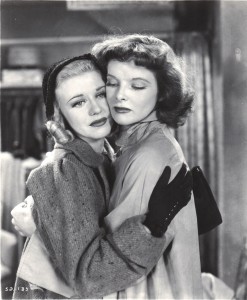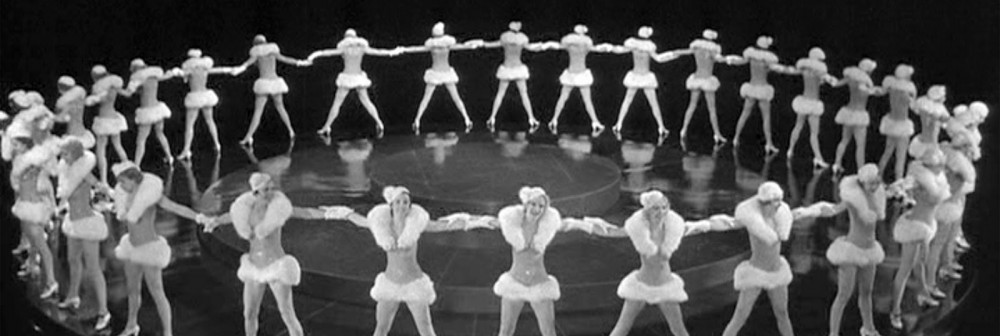The lack of queer theorization within the Doane and Mulvey pieces this week was disappointing. I realize they were already stepping in uncharted territory by looking closely at how women watch films, so diving into ideas of queer readings was not on their radar. But in their examinations of how women can alter the viewing practices that were so prevalent in the classic Hollywood era, for members of the queer female audience, lining up subjectivity in unexpected places is a stimulating alternative. One of my favorite films from the Hollywood studio era is Stage Door (1937). Directed by Gregory La Cava and starring an almost exclusive female cast including Katharine Hepburn, Ginger Rogers, Lucille Ball and Eve Arden among many others, this film for me is one of those exceptions to the rule of looking when it comes to the women within the film as well as those watching. The story revolves around aspiring actresses in New York who live together in a theatrical boarding house. The blue-blooded Hepburn enters into the scene and shakes things up with her upper class aura, and has a particular effect on the brassy Ginger Rogers. For me, their narrative resembles the boy meets girl, boy loses girl, boy gets girl back scenario that we’ve seen time and time again but this time enacted between two young women. They clash immensely in the beginning of the film but soon develop an affection for one another, largely because they are roommates in the house. And the penultimate scene which acts as a sort of climax, is the two of them embracing in a medium close-up, a very familiar sight.
There is little to no talk of men, and the only real prominent male character is a theater producer who seduces young actresses by promising them roles. In fact, when Hepburn deals with him she plays his game right along with him (masquerading one might say) in order to get the part. Her dabbling into heteronormative behavior is simply a tactic to get ahead, there is absolutely no emotional attachment involved.
The first meeting between Rogers and Hepburn is telling in the way that it is framed. La Cava uses the standard shot-reverse-shot in this scene, but instead of looks exchanged by a man and a woman, two women are given ample opportunity to look each other up and down, in the privacy of their own room to boot. Below is that clip, beginning at 1:55. Their witty banter as well as Rogers’ appearance in her bathrobe bring to mind many of the “meet-cute” moments that occur in numerous romantic comedies of the time. So, right off the bat there is a connection that the diagesis creates for these two women using techniques that usually connect a man and a woman.
http://www.tcm.com/mediaroom/video/304385/Stage-Door-Movie-Clip-Miss-Randall-s-Baggage.html
There are many fascinating aspects of Stage Door that feed into a queer reading of the film including Hepburn herself as a lesbian icon, the homosocial environment of the all-female boarding house, the lack of any genuine heterosexual narrative which was extremely rare at that time, as well as intimate moments between women when they share clothes or help one another get undressed after a long night out. But one of the most memorable examples involves Hepburn’s performance of heteronormativity. She comes from a very well off family and has decided to buck the trend of marrying a successful businessman in favor of moving into a very crowded house with a bunch of women. She does land a lead role in a Broadway play, though at the expense of one of the other housemates who had been vying for that same part. The housemate in question, Kay, eventually commits suicide because of the hopelessness she feels in her current situation. This role was to be her big break, and it was taken away from her. When we first see Hepburn at rehearsal attempting to feel a connection to the play, she is flat, lifeless and stiff. In the play’s scene, she is supposed to be mourning the loss of her male lover, but she is failing miserably. However, on opening night, the same night that Kay takes her own life, Hepburn performs flawlessly. Her performance is raw and heartfelt and affects everyone watching (including Rogers.) Importantly however her mind is not on this fictional male lover, but on the female friend whom she has just lost. Additionally, Rogers confronted her in her dressing room prior to the curtain going up and accused her of causing Kay’s death. So in Hepburn’s mind and emotions, she experiences the loss of her friend Kay as well as Rogers, her “special” friend. Below is the result of those feelings, a touching performance with her beloved friend Rogers looking on intently.
https://www.youtube.com/watch?v=WNtz0r5pmXo
Following this scene, Rogers rushes back into the dressing room and runs into Hepburn’s arms, signifying a truce and a reunification.

With that reconnection, like similar embraces in countless romantic movies, the film is able to end.
When I watch this movie, it is a touching story of female love mixed with a lot of wonderful and intelligent humor. Most likely that was not the intention of the filmmakers or the actresses playing these roles, but in my capacity as a female, queer viewer decide to read against the grain in order to derive pleasure from the text, rather than following the strict misogynist rules of spectatorship and subjectivity that dominated at the time.



